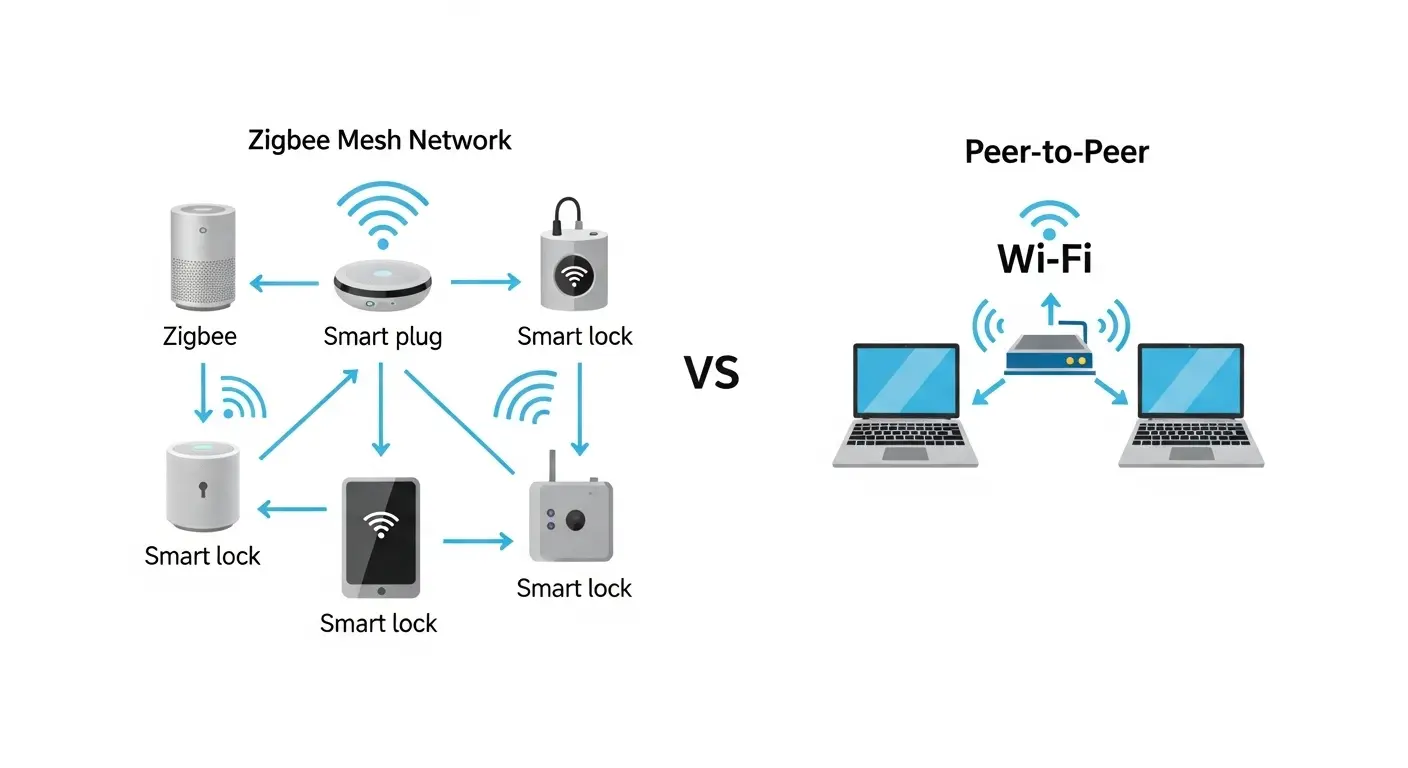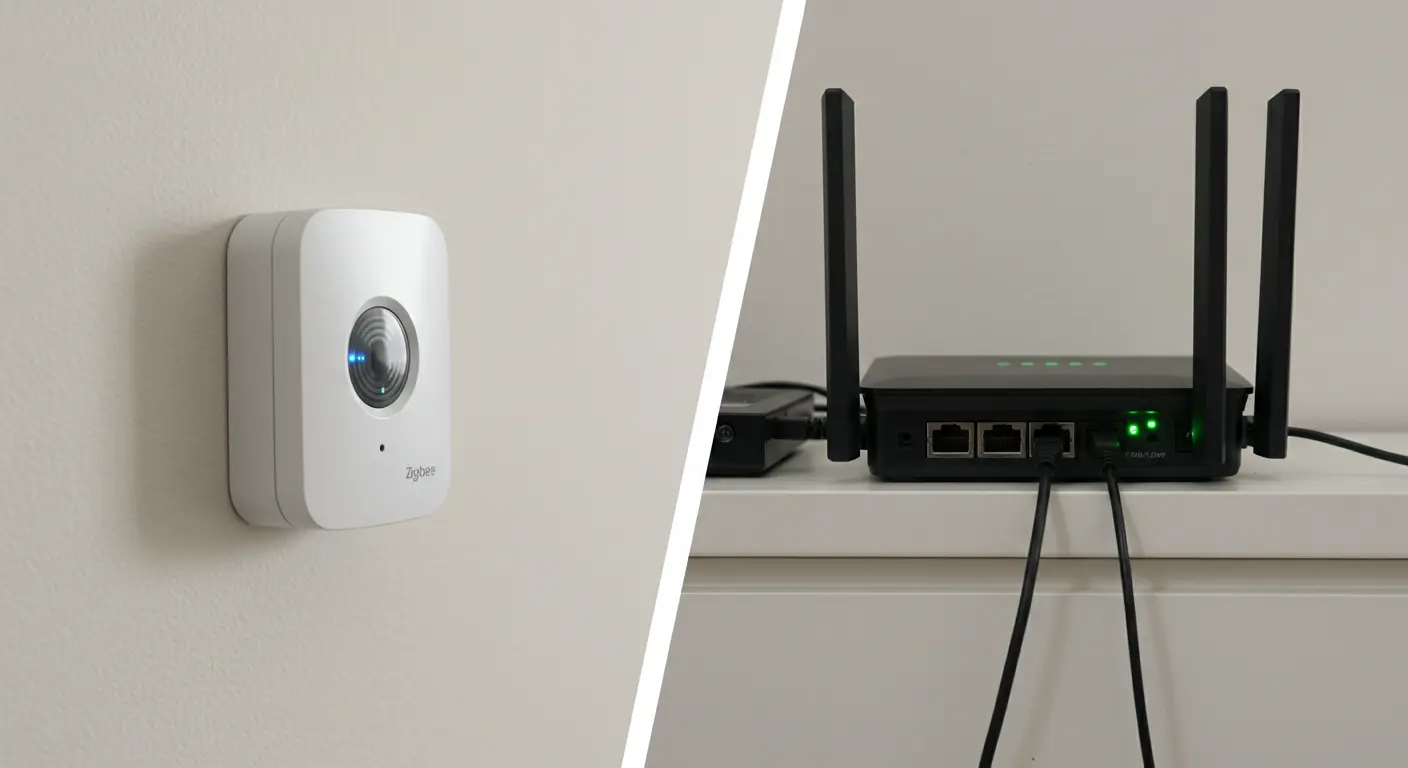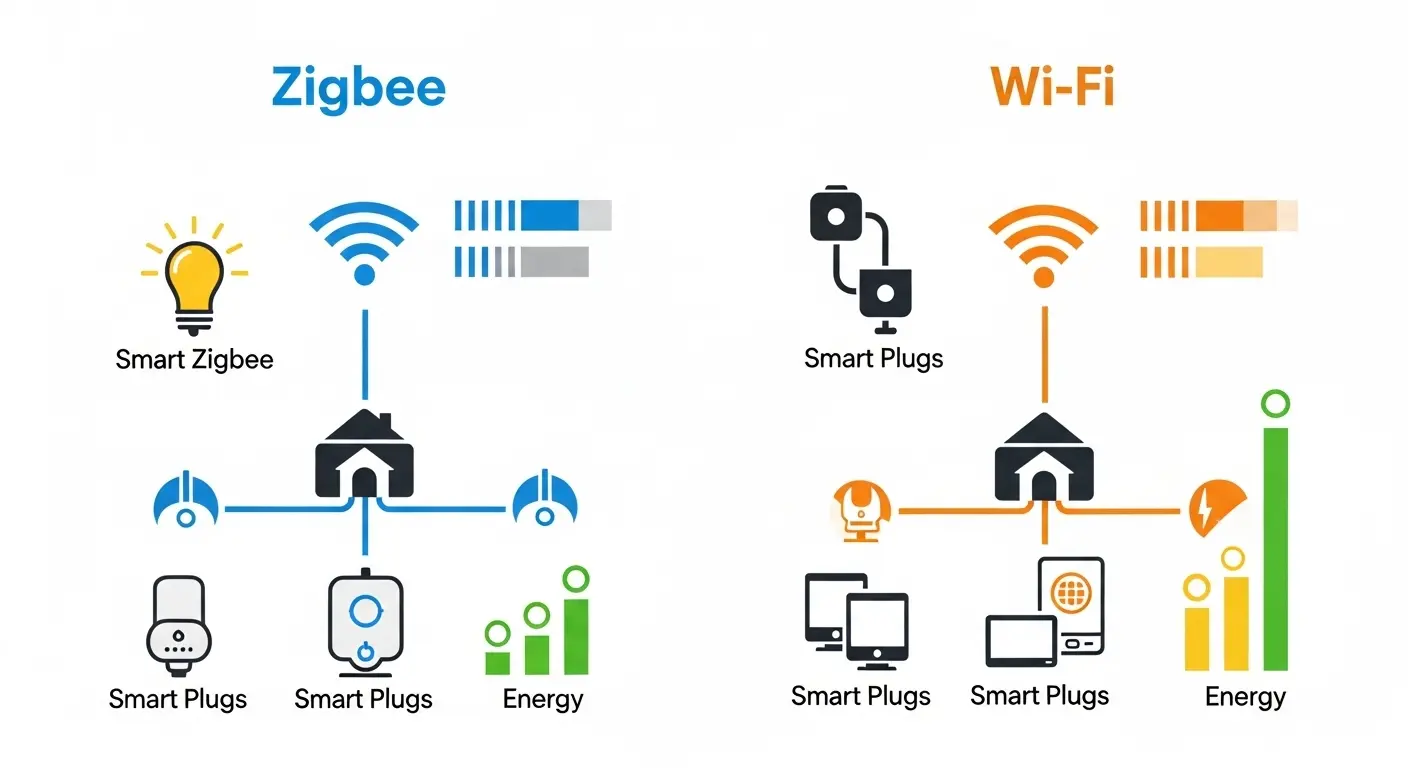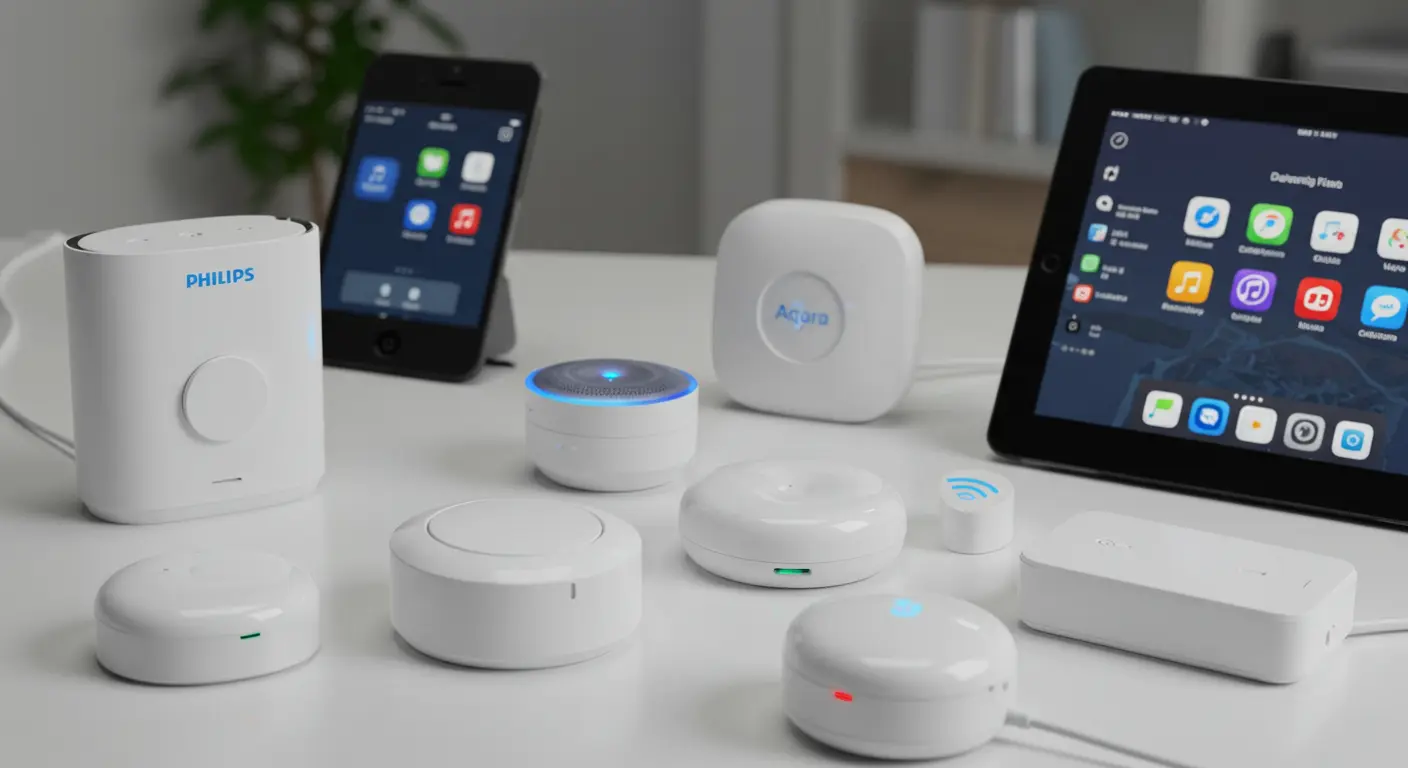
You’re setting up your smart home and you come across a common question: “Should I invest in a Zigbee system or stick with Wi-Fi devices?” Choosing the right protocol is crucial to ensure efficiency, compatibility, and organization in your home automation project.
While Wi-Fi is widely used and accessible, Zigbee has gained prominence due to its low power consumption and more fluid integration between devices.
In this article, you’ll discover everything you need to know about Zigbee and Wi-Fi, including their advantages, limitations, compatibility, and which option is ideal for your lifestyle and environment — whether you’re a beginner or already experienced in smart homes.
Advantages and Disadvantages of Zigbee and Wi-Fi
Choosing between Zigbee or Wi-Fi depends on several factors: type of residence, number of devices, residents’ routine, and automation goals. See the main pros and cons of each technology:
Zigbee: lightness, efficiency, and stability
Advantages
- Low power consumption: ideal for sensors and battery-powered devices.
- Robust mesh network: improves connection as more devices are added.
- High compatibility between brands: facilitated integration with hubs.
- Less interference with Wi-Fi and other signals.
Disadvantages
- Requires a hub or bridge to function.
- Initial installation may seem more technical.
- Lower bandwidth for heavy data (e.g., live video ).
Wi-Fi: practicality and familiarity
Advantages
- No hub required: connects directly to the router.
- Simpler for beginners.
- Easy to configure with manufacturers’ own apps.
Disadvantages
- Higher power consumption.
- Common interferences in large houses or with many walls.
- Congests the home network, potentially affecting internet performance.
Practical summary
If you are looking for energy efficiency and integration with multiple devices, Zigbee is the best choice. If you just want to connect a few basic appliances with practicality, Wi-Fi can work well — as long as the number of devices is controlled.
For a more in-depth technical view, access the official Zigbee protocol guide at the Connectivity Standards Alliance (CSA )

For Which Type of Home Is Each System Most Suitable?
When choosing between Zigbee or Wi-Fi, it’s essential to consider the type of residence, the physical structure of the environment, and the actual automation needs. Although both systems work well in different contexts, each presents specific advantages depending on the available space, the number of devices, and the desired level of integration.
Small spaces and apartments: which adapts better?
In compact environments, such as apartments and studios, Wi-Fi is usually the most practical choice — especially for those just starting out. This is because:
- Signal coverage is sufficient for smaller areas.
- Many basic smart devices (lights, cameras, switches ) already come with native Wi-Fi connectivity.
- Does not require initial investment in hubs or bridges.
However, it’s worth noting that as the number of devices increases, Wi-Fi can overload the network and generate instability. This is where Zigbee becomes a more efficient solution in the medium and long term.
📌 Read also: 👉 Smart Home for Beginners: What to Buy Without Overdoing It
Large homes and integrated environments
In larger residences, with multiple rooms and connected devices, Zigbee stands out for:
- Creating a mesh network, where each device reinforces the signal.
- Requiring less bandwidth from the main Wi-Fi network.
- Ensuring greater stability and quick response to commands, even over long distances.
Furthermore, Zigbee hubs connected to the central router allow managing hundreds of devices fluidly, something difficult to maintain on an overloaded Wi-Fi network.
When does it make sense to combine Zigbee and Wi-Fi?
The good news is that you don’t have to choose just one system. Many smart homes today combine the two protocols strategically:
- Simple and sporadic devices → Wi-Fi
- Critical routines, automations, and sensors → Zigbee
This hybrid approach offers the best of both worlds: practicality and integration, without sacrificing efficiency and stability.
💡 Tip: Before investing, map the type of automation you want in each room and evaluate how many devices you plan to use — this will help you make a more conscious and effective decision.
Power Consumption and Network Stability
When setting up a functional and fluid smart home, it’s essential to understand how Zigbee and Wi-Fi impact not only automation performance but also power consumption and network stability.
How each system affects your internet performance
One of the main challenges for those automating their home with Wi-Fi is network overload. This happens because:
- All smart devices compete for the signal with cell phones, computers, and other devices.
- In homes with unstable signals, there may be slow operation of lights, outlets, and sensors.
- It’s common to need to invest in more powerful routers or signal repeaters to maintain a stable connection.
Zigbee, on the other hand, by operating on a parallel and independent network, does not interfere with Wi-Fi. It creates a mesh network where devices communicate with each other, keeping home internet performance intact — ideal for those living in small spaces with limited signal or using the internet for remote work.
Energy, interference, and maintenance
Another important point is energy consumption and interference between devices:
- Zigbee operates with low power consumption, ideal for sensors and battery-powered devices. This increases autonomy and reduces the need for frequent maintenance.
- It is also less susceptible to interference, as it uses specific communication channels, even in environments with many connected devices.
- Wi-Fi tends to consume more energy and suffers interference more frequently, especially in compact environments with walls or furniture that block the signal.
If you are looking for stability and efficiency with the least possible impact on daily life, Zigbee can be the ideal way to keep your home connected, yet light and uncomplicated.

Device and Platform Compatibility
Choosing between Zigbee or Wi-Fi depends not only on the house’s structure but also on compatibility with the devices and platforms you already use — or plan to use. Knowing which brands integrate best with each system is essential to avoid frustrations and ensure fluid and intuitive operation.
Brands that work best with Wi-Fi
Wi-Fi is widely used in beginner smart homes for a simple reason: many popular devices are designed to work directly with it. Some brands that stand out:
- Positivo Casa Inteligente (Brazil )
- TP-Link Tapo
- Broadlink
- Tuya/Smart Life (with their own or integrated apps)
- Echo Show / Echo Dot with direct commands via Wi-Fi
These devices are easy to configure, generally do not require a hub, and can be controlled by an app or virtual assistant. For those seeking practicality and wanting to automate a few items, this is a functional option — but with limitations as the number of devices grows.
Devices that require Zigbee (Philips Hue, Aqara, Sonoff, etc.)
Some of the best devices in terms of efficiency, discreet design, and reduced consumption are exclusively compatible with Zigbee. This is because they were designed to operate within their own network, which is lighter and more reliable.
Examples of Zigbee-compatible brands and devices:
- Philips Hue (high-performance smart lighting)
- Aqara (sensors, controllers, and curtain motors)
- Sonoff Zigbee (outlets, sensors, and controllers)
- IKEA Tradfri (affordable lighting and automation with clean design)
- Tuya Zigbee (various devices for light automation)
These products generally require a Zigbee hub, but offer more stable connection, better range, and lower power consumption, in addition to deep integration with robust platforms.
Hubs and apps: Alexa, Google, Home Assistant, and SmartThings
Regardless of the chosen technology, centralized control is essential to avoid accumulating apps and loose commands. See how each platform handles integration:
- Amazon Alexa: works well with Wi-Fi and Zigbee (Echo 4th generation already has a built-in Zigbee hub).
- Google Home: easy integration with Wi-Fi devices; requires bridges for Zigbee.
- Home Assistant: ideal for advanced users, allows integrating multiple protocols (Wi-Fi, Zigbee, Z-Wave) with custom automations.
- SmartThings (Samsung): compatible with both protocols, with a focus on centralized control and deep integration with appliances.
💡 Tip: Before buying a new device, check if it is compatible with your virtual assistant or current control app. This avoids hub duplication and improves the organization of your smart system.

Is Zigbee Secure? Understand the Protection Protocols
When setting up a smart home, the security of data and the physical environment should be a priority. After all, we are talking about devices that control lights, cameras, doors, and sensors — and any vulnerability can compromise your privacy. Zigbee, in this scenario, presents good practices and robust protection protocols.
AES 128-bit encryption as standard
Zigbee uses AES 128-bit encryption, the same used by banks and financial services. This level of security ensures that data transmitted between devices and the hub is encoded, making interceptions or invasions difficult.
Additionally, each Zigbee device is authenticated upon entering the network, which prevents unauthorized connections.
Isolation of the Zigbee network from the main Wi-Fi
Another point in favor of security is the fact that Zigbee devices operate on a network independent of Wi-Fi. This means:
- Less exposure to internet attacks
- Less risk of invasions in case of Wi-Fi network failures
- Possibility of maintaining local (offline ) functions even without internet
This separation between networks offers an extra layer of protection — and also helps with automation stability.
Updates and local control
Although many Zigbee devices work via the cloud, there are models that operate 100% locally, without depending on the internet. This reduces exposure to external failures and ensures greater user control.
Additionally, hubs like Home Assistant, SmartThings, and Zigbee2MQTT offer support for regular updates and customizations that strengthen network security.
💡Tip: Always keep your hubs and devices updated and prefer recognized brands with support for OTA (over-the-air) updates, ensuring continuous protection against vulnerabilities.
Zigbee or Wi-Fi? Final Comparison with Table
After understanding how each technology works, its advantages and limitations, it’s time to put everything side by side. After all, which system is better for your smart home? The answer depends on your needs, the size of the environment, and your level of experience with automation.
While Wi-Fi is more accessible and direct for beginners, Zigbee shines in homes with multiple devices, where stability and efficient consumption are key differentiators.
Below, check out a comparative table with the main criteria to help in the decision:
| Criterion | Zigbee | Wi-Fi |
|---|---|---|
| Range | Medium, with expansion via mesh network between devices | High, but limited by walls and interference |
| Power Consumption | Very low (great for sensors) | High, requires constant power |
| Stability | High, even with many devices | Unstable with excessive connections |
| Compatibility | Requires hub or bridge to function | Works directly with router |
| Price | Medium, includes hub cost | Variable, but no hub needed |
| Installation Complexity | Requires initial setup with hub | Simple, ideal for beginners |
| Ideal for whom | Integrated homes, planned environments, advanced users | Beginners and small setups with existing Wi-Fi |
This comparison shows that there is no single answer: each protocol better serves a type of project. The important thing is to consider the balance between functionality, aesthetics, and control, especially if your goal is to maintain a smart home aligned with minimalism.
👉Read also: Zigbee Technology: Everything You Need to Know to Automate Your Home
Conclusion: Which to Choose for Your Smart Home?
Now that you know the strengths and limitations of Zigbee and Wi-Fi, the decision becomes simpler: it all depends on the user’s profile, the structure of your home, and how deeply you want to delve into the world of automation.
Profile 1 – Beginners with few devices
If you are taking your first steps, want to automate lights, outlets, and perhaps a smart lock, Wi-Fi is the most direct path. It eliminates the need for hubs, works with the devices you already have, and offers basic integration with Alexa and Google. Ideal for apartments or small setups.
Profile 2 – Intermediate users focused on energy saving
For those who want more control over energy consumption, more efficient sensors, and greater connection stability, Zigbee offers smarter and more sustainable automation features. An excellent choice for those looking for an efficient and functional smart home, without needing cables or high energy consumption.
Profile 3 – Advanced users seeking total integration
If you intend to transform your entire home into an automated environment, with dozens of devices communicating fluidly and without overloading Wi-Fi, Zigbee is unbeatable. Integration with hubs like Home Assistant or SmartThings allows you to create a complete, personalized, and discreet experience — perfect for a minimalist and sophisticated smart home project.
🔍 Final tip: Zigbee and Wi-Fi don’t have to compete — in many projects, they complement each other. While one manages sensors and automations with energy efficiency, the other can handle larger devices, such as cameras and voice assistants. The secret lies in balance.
